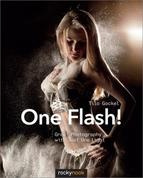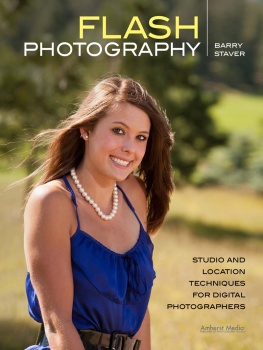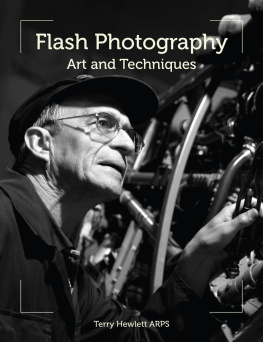Tilo Gockel (fotopraxis.net)
Editor: Joan Dixon
Translator: Jeremy Cloot
Copyeditor: Jeanne Hansen
Layout: Jan Mart, Command Z
Cover Design: Helmut Kraus, www.exclam.de
Printer: Friesens Corporation
Printed in Canada
ISBN: 978-1-937538-46-0
1st Edition 2014
2014 by Tilo Gockel
Translation by Rocky Nook, Inc.
802 E. Cota Street, 3rd Floor
Santa Barbara, CA 93103
www.rockynook.com
This is an authorized translation of the German 1st edition 2013 by Galileo Press GmbH. This translation is published and sold by permission of Galileo Press GmbH, the owner of all rights to publish and sell the same.
Library of Congress Cataloging-in-Publication Data
Gockel, Tilo.
Creative flash photography : great lighting with small flashes: 40 flash workshops / by Tilo Gockel. -- 1st edition.
pages cm
ISBN 978-1-937538-46-0 (softcover : alk. paper)
1. Electronic flash photography. I. Title.
TR606.G63 2014
778.7'2--dc23
2014013449
All rights reserved. No part of the material protected by this copyright notice may be reproduced or utilized in any form, electronic or mechanical, including photocopying, recording, or by any information storage and retrieval system, without written permission of the publisher.
Many of the designations in this book used by manufacturers and sellers to distinguish their products are claimed as trademarks of their respective companies. Where those designations appear in this book, and Rocky Nook was aware of a trademark claim, the designations have been printed in caps or initial caps. All product names and services identified throughout this book are used in editorial fashion only and for the benefit of such companies with no intention of infringement of the trademark. They are not intended to convey endorsement or other affiliation with this book. Unless otherwise stated, the product names and trademarks mentioned in the text are the registered property of their respective owners and are subject to the appropriate laws. These products and trademarks include Adobe Photoshop, Canon, Sigma, Tamron, Manfrotto, Yongnuo, and Lipton, among others. The product photos found in these pages are not intended for advertising purposes and were not shot on request of their manufacturers. They serve exclusively to illustrate the photographic techniques detailed in the accompanying text.
While reasonable care has been exercised in the preparation of this book, the publisher and author assumes no responsibility for errors or omissions, or for damages resulting from the use of the information contained herein or from the use of the discs or programs that may accompany it.
This book is printed on acid-free paper.
Did you know that I am an available light photographer?
I look in my bag, see that my Vivitar 285 or Sunpak 180j or
Nikon Speedlite is available to me and I use that.
~ Zack Arias
Youve gotta taste the light. And when you see light like this, trust me,
its like a strawberry sundae with sprinkles.
~ Joe McNally
Authors Foreword
Maybe you feel the same way I did when I first came across flash. I was certainly skeptical and had the harsh look of the typical mug shot in mind, and I had reservations about tackling the technology. My first flash was a computer flash with functionality that eluded me. But after I repeatedly saw the fantastic images by David Strobist Hobby, Zack Arias, Joe McNally, Ryan Brenizer, and Neil van Niekerk, my curiosity got the better of me. The Strobist blog (strobist.blogspot. com) and Davids Lighting 101 and Lighting 102 tutorials offered a perfect introduction to the world of flash technique. I am especially proud of the fact that the Strobist himself has contributed an exclusive foreword to this book. Thanks, Davidthis book probably wouldnt exist without you!
I quickly learned that flash doesnt have to automatically kill an image with bright light, red eyes, and hard-edged shadows. In fact, it is more like a pocket sun that canwith a little practicebe used to emulate and enhance natural light in a range of situations. I soon began to keep a diary of the lighting setups that are now part of this book. It includes lighting diagrams, the photos that resulted from each session, and a wealth of information describing how I took each image.
The book is divided in two main sections. contains a crash course in basic flash technique. There is also an introduction to the flash gear I have found useful over the years, which I hope will save you the time and money I spent trying out a lot of useless accessories.
contains 40 workshops with detailed explanations of various flash scenarios, including people, portraits, high-speed flash, macro, products, food, and more. The workshops highlight specific lighting and flash techniquessuch as cross lighting and high-speed sync, or dragging the shutterand give you a solid set of tools that will allow you to light any scene effectively. The techniques range from the simple use of your cameras built-in flash to stroboscopic setups with seven or more off-camera flashes. Other sections address techniques such as pseudo-HSS/Supersync, key shifting, infrared triggers, projecting patterns with gobos, and much more. Things get really interesting when you begin to practice and combine the techniques to develop your own unique style.
I have never found an adequate explanation of how to precisely and easily calculate an exposure when using both flash and ambient light, so introduces some useful tools for creating lighting diagrams. Additional appendices contain a valuable list of additional resources and a glossary of useful terms for the strobist.
Because I am a Canon user, you might find this book somewhat specific to Canon gear, although I refer to the Nikon equivalents wherever possible. Gear manufactured by Metz, Pentax, and others is just as effective as the equipment I describe, and as soon as you switch to manual mode you are free to use whatever brand you want anyway.
And now I wish you great lighting and a constant stream of wow moments with your own flash images.
Tilo Gockel
Please send your comments, criticisms, and other feedback (including inquires regarding the models shown in this book) to .
Foreword by David Hobby
I was seven years old the first time I can remember using a camera. It was 1972. We were at a family reunion, and my uncle let me use his new Canonet G-III. To me it seemed like magic, and I was hooked. Just one year later I had my own camera and a small darkroom in a shed in my backyard. Watching an image appear in the developer tray was yet more magic. From that point on I was rarely seen without a camera in my hand. In high school, a staff position on the class yearbook meant two things: first, I had license to explore the school with my camera; second, someone else was paying for my film. Five years later I was a newspaper photojournalist, a career that I would enjoy for 25 years. Many of those years were spent shooting black-and-white film, where light quality was a luxury and the color of the light really didnt matter.
That all changed when we switched to color film, especially because we shot transparencies. All of a sudden, light mattered. It mattered a lot. We needed to learn how to improve the lighting by combining ambient light and electronic flash. If you kept the flash on your camera, the results were fairly safe and predictable. For a newspaper photographer shooting in lots of run-and-gun situations, safety and predictability were good things. A flash on a camera is good at one thing: illuminating detail; but you are essentially lighting with all the creativity of a photocopier. We quickly learned that if we took the small flashes off our cameras, safety and predictability were replaced by magic and surprise. The magic was that our photos could capture the world in a much more three-dimensional way. With a difference between lens position and light position form and texture could be shown. The surprise was that the results were pretty unpredictable, thanks to the unforgiving exposure latitude of transparency film and the fact that we had to wait until the film was processed to see the results of our lighting experiments. So we played it safe and over time learned how to light.
Next page




